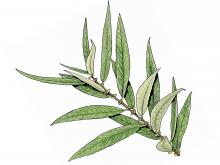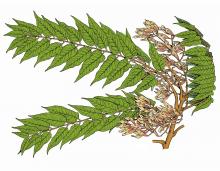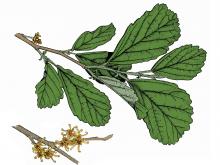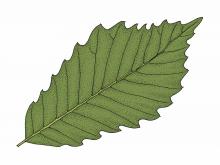Trees, Shrubs and Woody Vines
Media

Species Types
Scientific Name
Salix caroliniana
Description
Ward's willow, or Carolina willow, is one of the first woody species to occupy the outer edges of gravel bars in a stream. Common in the Ozarks, it occurs nearly statewide.
Media

Species Types
Scientific Name
Quercus phellos
Description
Willow oak's leaves are narrow, pointed, and willowlike, and like willows, this oak is associated with wet ground. In Missouri, willow oak is only found natively in our southeastern counties.
Media

Species Types
Scientific Name
Quercus imbricaria
Description
Shingle oak got its name because the naturalist who discovered it noticed that French colonists in Illinois were using the wood to make roofing shingles. The leaves resemble those of laurel (bay), lacking lobes or teeth — but laurel trees don't bear acorns!
Media

Species Types
Scientific Name
Ailanthus altissima
Description
Tree-of-heaven is a fast-growing exotic that is common in urban areas. It is weedy and aggressive and should not be planted. It has 2-foot-long feather-compound leaves. Twigs smell unpleasant when you break them.
Media

Species Types
Scientific Name
Cornus alternifolia
Description
Dogwoods usually have leaves arranged opposite one another on the stem, except for the alternate-leaved dogwood! This shrub or small tree is a popular ornamental, especially in the northern parts of Missouri, where it can be too cold to grow flowering dogwood.
Media

Species Types
Scientific Name
Cornus spp.
Description
Missouri’s five species of dogwoods are shrubs or small trees with distinctive flowers, fruits, and bark. The fruits may be red, white, or blue. The leaves have characteristic arching veins.
Media

Species Types
Scientific Name
Fagus grandifolia
Description
Limited in our state to well-drained, sandy soils in southeast Missouri, American beech is an impressive tree that has provided Americans with wood for a variety of uses, from furniture to toys to fuel to beer barrels!
Media

Species Types
Scientific Name
Hamamelis vernalis
Description
Ozark witch-hazel is a large native shrub that grows along dry, rocky streambeds in southern and east-central Missouri. The yellow, ribbonlike flowers bloom as early as January. In the fall, the seeds are ejected forcefully, to a distance of up to 30 feet!
Media

Species Types
Scientific Name
Quercus muehlenbergii
Description
Chinkapin oak is fairly easy to identify because of its distinctively toothed leaves. Look for it growing in rocky soils derived from limestone or dolomite on bluffs and in upland woods, and in floodplain forests and lower slopes along streams.
Media

Species Types
Scientific Name
Cladrastis kentukea
Description
Early Appalachian settlers gave yellowwood its name because the root bark produces a clear yellow dye. This slow-growing tree is popular statewide as a landscaping ornamental, but in the wild it is uncommon to endangered throughout its natural range.
See Also
About Trees, Shrubs and Woody Vines in Missouri
There are no sharp dividing lines between trees, shrubs, and woody vines, or even between woody and nonwoody plants. “Wood” is a type of tissue made of cellulose and lignin that many plants develop as they mature — whether they are “woody” or not. Trees are woody plants over 13 feet tall with a single trunk. Shrubs are less than 13 feet tall, with multiple stems. Vines require support or else sprawl over the ground.





















